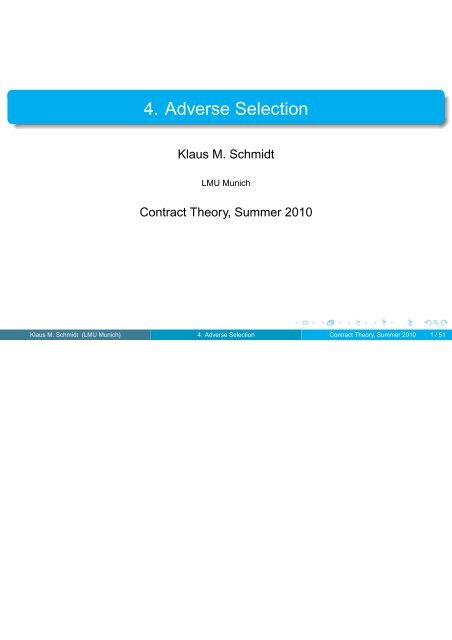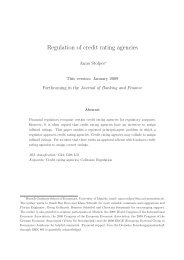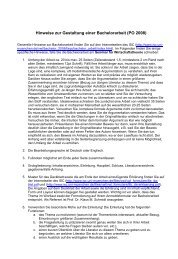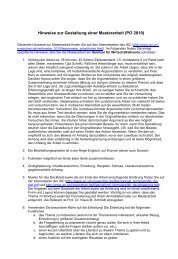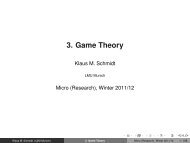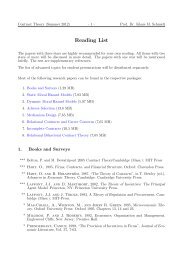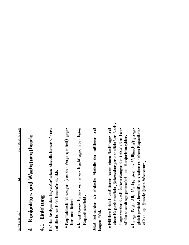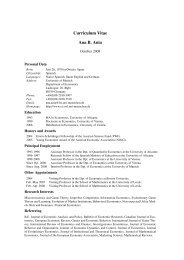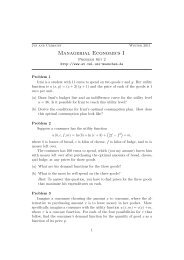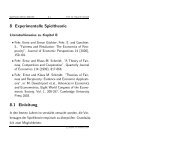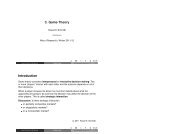x - Economic Theory (Prof. Schmidt) - LMU
x - Economic Theory (Prof. Schmidt) - LMU
x - Economic Theory (Prof. Schmidt) - LMU
Create successful ePaper yourself
Turn your PDF publications into a flip-book with our unique Google optimized e-Paper software.
4. Adverse Selection<br />
Klaus M. <strong>Schmidt</strong><br />
<strong>LMU</strong> Munich<br />
Contract <strong>Theory</strong>, Summer 2010<br />
Klaus M. <strong>Schmidt</strong> (<strong>LMU</strong> Munich) 4. Adverse Selection Contract <strong>Theory</strong>, Summer 2010 1 / 51
Basic Readings<br />
Basic Readings<br />
Textbooks:<br />
Papers:<br />
Bolton and Dewatripont (2005), Chapters 2 and 9<br />
Fudenberg and Tirole (1991, Chapter 7)<br />
Laffont and Martimort (2002), Chapter 2<br />
<strong>Schmidt</strong> (1995), Chapter 4<br />
Baron and Myerson (1982)<br />
Laffont and Tirole (1988)<br />
Klaus M. <strong>Schmidt</strong> (<strong>LMU</strong> Munich) 4. Adverse Selection Contract <strong>Theory</strong>, Summer 2010 2 / 51
Introduction<br />
Introduction<br />
Definition of adverse selection?<br />
Adverse selection in markets and in bilateral contracts.<br />
Examples for adverse selection?<br />
Why is it important that the uninformed party makes a take-it-or-leave-it<br />
offer?<br />
Is this assumption a restriction or without loss of generality?<br />
Klaus M. <strong>Schmidt</strong> (<strong>LMU</strong> Munich) 4. Adverse Selection Contract <strong>Theory</strong>, Summer 2010 3 / 51
The Two-Types Case<br />
The Tow-Types Case<br />
Price discrimination: A monopolist does not know the type of his customer(s):<br />
c constant marginal cost of production<br />
q quantity of production<br />
θ type of the customer, θ ∈ {θ,θ}<br />
p probability that the monopolist assigns to the event that the customer<br />
is of type θ.<br />
t total payment of the customer to the monopolist.<br />
The customer knows his own type, the monopolist knows only the ex ante<br />
probabilities (p, 1−p) for each type.<br />
Klaus M. <strong>Schmidt</strong> (<strong>LMU</strong> Munich) 4. Adverse Selection Contract <strong>Theory</strong>, Summer 2010 4 / 51
The Two-Types Case<br />
We will assume here that there is only one customer. Alternatively, we could<br />
assume that there is a continuum of customers with mass 1, the fraction p of<br />
which is of type θ. The formal analysis is the same.<br />
Payoff functions:<br />
U(q, t,θ) = θu(q)−t<br />
Π(q, t) = t − c · q<br />
Both parties are risk neutral. If the consumer does not consume anything, he<br />
gets a reservation utility of 0.<br />
Klaus M. <strong>Schmidt</strong> (<strong>LMU</strong> Munich) 4. Adverse Selection Contract <strong>Theory</strong>, Summer 2010 5 / 51
The First Best Allocation<br />
If there was no informational asymmetry, the principal would offer a contract<br />
that solves the following problem:<br />
subject to<br />
max<br />
q,t<br />
t − cq<br />
(PC) θu(q)−t ≥ 0 .<br />
In the optimal solution (PC) must hold with equality. (Why?) Thus, the first<br />
best allocation is characterized by<br />
and<br />
t = θu(q)<br />
θu ′ (q) = c .<br />
Klaus M. <strong>Schmidt</strong> (<strong>LMU</strong> Munich) 4. Adverse Selection Contract <strong>Theory</strong>, Summer 2010 6 / 51
The First Best Allocation<br />
Remarks:<br />
1. The monopolist extracts all the rents from his customer<br />
2. He chooses a production level such that marginal utility (or rather the<br />
MRS between this good and the expenditures for all other goods) equals<br />
marginal cost.<br />
3. t and q are both functions of θ. This can also be written as an non-linear<br />
pricing scheme t(q) (second degree price discrimination).<br />
Klaus M. <strong>Schmidt</strong> (<strong>LMU</strong> Munich) 4. Adverse Selection Contract <strong>Theory</strong>, Summer 2010 7 / 51
The Revelation Principle<br />
What kind of contract should the principal offer if he does not know the agent’s<br />
type?<br />
There are infinitely many types of contracts (“mechanisms”) that could be<br />
offered:<br />
a non-linear pricing scheme t(q)<br />
a revelation mechanism {t( ˆ θ), q( ˆ θ)}<br />
a lottery: the customer buys lottery tickets at certain prices that<br />
determine his probability of “winning” a certain amount q.<br />
a multi-stage contract: the agent first has to pay an entrance fee, then<br />
some multi-stage game between the principal and the agent is played,<br />
the outcome of which determines the allocation<br />
etc.<br />
Klaus M. <strong>Schmidt</strong> (<strong>LMU</strong> Munich) 4. Adverse Selection Contract <strong>Theory</strong>, Summer 2010 8 / 51
The Revelation Principle<br />
Thus, the problem is that the set of contracts over which the principal wants to<br />
maximize his utility is not well defined, and if we wanted to define it, if would<br />
be an incredibly complex object.<br />
However, the Revelation Principle tells us, that any allocation that can be<br />
implemented at all, can also be implemented by using a direct revelation<br />
mechanism. Therefore, without loss of generality, we can restrict attention to<br />
direct revelation mechanisms which is a much simpler set of objects.<br />
The Revelation Principle is extremely important. To fully understand it, we<br />
need a few definitions:<br />
Definition 1<br />
An allocation, (q(θ), t(θ)), is a function that assigns to each possible type of<br />
the agent a consumption quantity q and a payment t.<br />
Klaus M. <strong>Schmidt</strong> (<strong>LMU</strong> Munich) 4. Adverse Selection Contract <strong>Theory</strong>, Summer 2010 9 / 51
The Revelation Principle<br />
Definition 2<br />
A mechanism is a game form, i.e. a set of strategies for the agent and a<br />
function (q(s), t(s)) that assigns to each possible strategy of the agent an<br />
outcome (q, t).<br />
What is the difference between a game form and a game?<br />
Definition 3<br />
A revelation mechanism (or direct mechanism) (q(ˆθ), t(ˆθ)) is a mechanism,<br />
in which the agent is asked to announce his type, i.e., the agent’s strategy<br />
space S is the set of possible types Θ. Furthermore, a revelation mechanism<br />
has to be incentive compatible, i.e., for each possible type of the agent it<br />
has to be optimal to announce his type truthfully ( ˆ θ = θ).<br />
Klaus M. <strong>Schmidt</strong> (<strong>LMU</strong> Munich) 4. Adverse Selection Contract <strong>Theory</strong>, Summer 2010 10 / 51
The Revelation Principle<br />
Definition 4<br />
A mechanism {S,(q(s), t(s))} implements an allocation (q(θ), t(θ)) if and<br />
only if for every possible type θ ∈ Θ there exists an optimal strategy s ∗ (θ),<br />
such that<br />
(q(s ∗ (θ)), t(s ∗ (θ))) = (q(θ), t(θ))<br />
Klaus M. <strong>Schmidt</strong> (<strong>LMU</strong> Munich) 4. Adverse Selection Contract <strong>Theory</strong>, Summer 2010 11 / 51
The Revelation Principle<br />
Proposition 4.1 (Revelation Principle)<br />
The allocation function (q(θ), t(θ)) can be implemented by some (arbitrarily<br />
complicated) mechanism if and only if it can also be implemented by a (direct)<br />
revelation mechanism.<br />
Proof: Let (q(θ), t(θ)) be an allocation that can be implemented by a<br />
mechanism {S,(q(s), t(s))}. Then there exists for each type θ ∈ Θ an optimal<br />
strategy s ∗ (θ), such that<br />
(q(s ∗ (θ)), t(s ∗ (θ))) = (q(θ), t(θ))<br />
Let us now construct another mechanism<br />
<br />
Θ,(q( ˆ θ), t( ˆ <br />
θ))<br />
If the agent claims to be type ˆ θ, then the allocation<br />
(q(s ∗ ( ˆ θ)), t(s ∗ ( ˆ θ))) will be implemented.<br />
as follows:<br />
Note that if each type tells the truth ( ˆ θ = θ), then this direct mechanism<br />
implements exactly the same allocation as the indirect mechanism we started<br />
Klaus M. <strong>Schmidt</strong> (<strong>LMU</strong> Munich) 4. Adverse Selection Contract <strong>Theory</strong>, Summer 2010 12 / 51
The Revelation Principle<br />
with. It remains to be shown that truthtelling is indeed optimal for each type of<br />
agent:<br />
Note that s ∗ (θ) is an optimal strategy in the original mechanism. Therefore we<br />
have:<br />
In particular:<br />
θu(q(s ∗ (θ)))−t(s ∗ (θ)) ≥ θu(q(s)))−t(s) ∀ s ∈ S<br />
θu(q(s ∗ (θ)))−t(s ∗ (θ)) ≥ θu(q(s ∗ ( ˜ θ)))−t(s ∗ ( ˜ θ)) ∀ ˜ θ ∈ Θ<br />
By the definition of our direct mechanism it follows that:<br />
θu(q(θ))−t(θ) ≥ θu(q( ˜ θ))−t( ˜ θ) ∀ ˜ θ ∈ Θ<br />
But this means that it is indeed optimal for each type θ ∈ Θ to announce θ<br />
truthfully. Q.E.D.<br />
Klaus M. <strong>Schmidt</strong> (<strong>LMU</strong> Munich) 4. Adverse Selection Contract <strong>Theory</strong>, Summer 2010 13 / 51
The Revelation Principle<br />
Remarks:<br />
1. We have proved the revelation principle in the specific context of the price<br />
discrimination problem. However, it is straightforward to generalize this<br />
result to any other problem with adverse selection.<br />
2. There are different types of implementation, corresponding to different<br />
notions of equilibrium, e.g.:<br />
dominant strategy implementation (equilibrium in dominated strategies)<br />
full implementation (unique Nash equilibrium)<br />
truthful implementation (truthtelling is just one of potentially many Nash<br />
equilibria)<br />
Bayesian Nash implementation<br />
subgame perfect implementation (truthtelling is a unique, subgame perfect<br />
equilibrium)<br />
virtual implementation<br />
etc.<br />
Most of these concepts coincide if there is only one agent. Why?<br />
However, with multiple agents these concepts are quite different. See<br />
Moore (1992) for a brilliant survey of this literature.<br />
Klaus M. <strong>Schmidt</strong> (<strong>LMU</strong> Munich) 4. Adverse Selection Contract <strong>Theory</strong>, Summer 2010 14 / 51
The Revelation Principle<br />
3. The revelation principle requires that the principal can fully commit to the<br />
terms of the contract. If this is not the case, an indirect mechanism, which<br />
allows for some commitment, may strictly outperform any direct revelation<br />
mechanism, which allows for no commitment.<br />
Klaus M. <strong>Schmidt</strong> (<strong>LMU</strong> Munich) 4. Adverse Selection Contract <strong>Theory</strong>, Summer 2010 15 / 51
How to Solve the Two-Types Case<br />
How to Solve the Tow-Types Case?<br />
Let q = q(θ), q = q(θ), etc. The Second Best Problem can be written as the<br />
following optimization problem:<br />
subject to:<br />
max<br />
q,q,t,t<br />
p(t − cq)+(1−p)(t − cq)<br />
(IC1) θu(q)−t ≥ θu(q)−t ,<br />
(IC2) θu(q)−t ≥ θu(q)−t ,<br />
(PC1) θu(q)−t ≥ 0 ,<br />
(PC2) θu(q)−t ≥ 0 ,<br />
Klaus M. <strong>Schmidt</strong> (<strong>LMU</strong> Munich) 4. Adverse Selection Contract <strong>Theory</strong>, Summer 2010 16 / 51
How to Solve the Two-Types Case<br />
We will solve this problem in a sequence of steps:<br />
Step 1: (PC2) is redundant and can be ignored:<br />
θu(q)−t ≥ θu(q)−t (1)<br />
(1) is (IC2), (2) is implied by θ > θ and (3) holds by (PC1).<br />
≥ θu(q)−t (2)<br />
≥ 0 (3)<br />
Step 2: (PC1) must be binding in the optimal solution. If this was not the case,<br />
then it would be possible to increase t and t by ɛ > 0 without violating any<br />
constraint. This would further increase the principal’s payoff, a contradiction.<br />
Klaus M. <strong>Schmidt</strong> (<strong>LMU</strong> Munich) 4. Adverse Selection Contract <strong>Theory</strong>, Summer 2010 17 / 51
How to Solve the Two-Types Case<br />
Step 3: (IC2) must be binding in the optimal solution. If this was not the case,<br />
the principal could increase t without violating any other constraint, a<br />
contradiction. To see this, illustrate the indifference curves of the different<br />
types graphically in the q, t space:<br />
θu(q)−t = const ⇒ t = θu(q)−const<br />
The indifference curves are concave (u ′′ (·) < 0), and for each q I(θ) is<br />
steeper than I(θ). This implies that the indifference curves of the different<br />
types can cross only once. This is the famous “single crossing property”.<br />
Without this property, adverse selection problems are very hard to solve.<br />
Note that I(θ) must pass through the origin of the diagram, because we know<br />
already that (PC1) must be binding at the optimum.<br />
Klaus M. <strong>Schmidt</strong> (<strong>LMU</strong> Munich) 4. Adverse Selection Contract <strong>Theory</strong>, Summer 2010 18 / 51
How to Solve the Two-Types Case<br />
Let point A represent the contract that is supposed to be chosen by type θ.<br />
Consider the indifference curve I(θ) through this point.<br />
The contract for type θ (point B) cannot be to the left/above of I(θ),<br />
otherwise type θ would choose contract A.<br />
It cannot be to right/below I(θ) either, otherwise type θ would choose<br />
contract B.<br />
Hence, q ≤ q. This monotonicity condition is a direct implication of<br />
incentive compatibility.<br />
Suppose, B is strictly below I(θ). Then we could increase t a little bit without<br />
violating the incentive compatibility or participation constraint for type θ. This<br />
would improve the principal’s payoff, a contradiction.<br />
Klaus M. <strong>Schmidt</strong> (<strong>LMU</strong> Munich) 4. Adverse Selection Contract <strong>Theory</strong>, Summer 2010 19 / 51
How to Solve the Two-Types Case<br />
Step 4: If q > q, then (IC1) is not binding. This is obvious from the graphical<br />
illustration in this example. In other examples it may be more difficult to show.<br />
In this case it may be better to ignore (IC1), to solve the relaxed problem, and<br />
to check afterwards whether the solution to the relaxed problem satisfies<br />
(IC1).<br />
Step 5:<br />
(PC1) ⇒ t = θu(q)<br />
(IC2) ⇒ t = θu(q)− θu(q)−θu(q) <br />
<br />
information rent<br />
Hence, our optimization problem reduces to:<br />
FOCs:<br />
max<br />
q,q<br />
p θu(q)−cq +(1−p) θu(q)−θu(q)+θu(q)−cq <br />
∂<br />
∂q = u′ (q) θ −(1−p)θ − pc =<br />
<br />
≤ 0 if q = 0<br />
= 0 if q > 0<br />
Klaus M. <strong>Schmidt</strong> (<strong>LMU</strong> Munich) 4. Adverse Selection Contract <strong>Theory</strong>, Summer 2010 20 / 51
How to Solve the Two-Types Case<br />
∂<br />
∂q = u′ (q)(1−p)θ −(1−p)c =<br />
<br />
≤ 0 if q = 0<br />
= 0 if q > 0<br />
The second order conditions are globally satisfied. To guarantee an interior<br />
solution we assume that θ > (1−p)θ (otherwise q = 0 is optimal), and<br />
limq→0 u ′ (q) = ∞ (otherwise it would not be guaranteed that u ′ (q) is<br />
sufficiently large to guarantee an interior solution.<br />
In an interior solution, the FOCs hold with equality:<br />
θu ′ (q) =<br />
θu ′ (q) = c<br />
c<br />
1− (1−p)<br />
p<br />
(θ−θ)<br />
θ<br />
It is now straightforward to check algebraically that (IC1) holds.<br />
Klaus M. <strong>Schmidt</strong> (<strong>LMU</strong> Munich) 4. Adverse Selection Contract <strong>Theory</strong>, Summer 2010 21 / 51
Interpretation<br />
Interpretation of the Optimal Solution<br />
1) q = q FB (θ), i.e., “no distortion at the top”. This property holds in all<br />
adverse selection models in which the single crossing property is<br />
satisfied.<br />
2) q < q FB (θ), i.e., the “bad” type is distorted and consumes too little.<br />
3) The intuition for these results is as follows: Note first that q FB (θ) < q FB (θ).<br />
Suppose now that q = q FB (θ). The we can move along the indifference<br />
curve of type θ to q FB (θ) without violating any constraint. This leaves both<br />
types of agent indifferent and increases the principal’s payoff.<br />
Klaus M. <strong>Schmidt</strong> (<strong>LMU</strong> Munich) 4. Adverse Selection Contract <strong>Theory</strong>, Summer 2010 22 / 51
Interpretation<br />
Why is q < q FB (θ)?<br />
The principal could implement the first best and offer a contract A’ to the bad<br />
customer which induces him to consume efficiently.<br />
However, in this case he would have to offer the contract B’ to the good<br />
customer in order to prevent him from choosing A’ as well. This means that<br />
the good type has to get a higher information rent.<br />
Suppose the principal reduces q starting from q FB (θ) a little bit along the<br />
indifference curve I(θ). This does not affect the agent and results in a<br />
second order welfare loss. Hence, the principals loss is also of second order.<br />
On the other hand he can now increase t which yields an additional first<br />
order profit.<br />
Hence, it is always optimal for the principal to distort the quantity of the bad<br />
type a little bit in order to reduce the rent that has to be left to the good type.<br />
Klaus M. <strong>Schmidt</strong> (<strong>LMU</strong> Munich) 4. Adverse Selection Contract <strong>Theory</strong>, Summer 2010 23 / 51
Interpretation<br />
4) The degree of the distortion depends on the relative likelihood of facing<br />
the bad customer. If his probability is close to 1, then the distortion will be<br />
close to 0. In this case the expected information rent is very small<br />
anyway. On the other hand, the smaller p, the larger is the optimal<br />
distortion. There exists an p, such that q = 0 if p < p. If q = 0, the<br />
principal does not have to pay any information rent to the agent:<br />
t = θu(q)− θu(q)−θu(q) <br />
<br />
=0<br />
5) In a standard adverse selection problem, there is a trade-off between<br />
achieving allocative efficiency and minimizing the agent’s rent.<br />
Klaus M. <strong>Schmidt</strong> (<strong>LMU</strong> Munich) 4. Adverse Selection Contract <strong>Theory</strong>, Summer 2010 24 / 51<br />
.
A Continuum of Types<br />
A Continuous Type Model<br />
V = v(x,θ)−t principal’s payoff function<br />
U = u(x,θ)+t agent’s payoff function<br />
x ∈ [0, x] agent’s action, observable and verifiable<br />
t ∈ ℜ transfer from P to A (reverse notation!)<br />
θ ∈ [0, 1] agent’s type (private information)<br />
F(θ) probability distribution over θ<br />
f(θ) density of θ, f(θ) > 0 ∀ θ ∈ [0, 1].<br />
Remarks:<br />
1. Both payoff functions are linear in t, i.e., both players are risk neutral.<br />
2. Specification is quite general. Examples:<br />
procurement problems (e.g. Laffont and Tirole, 1993)<br />
price regulation of a monopolist with unknown cost (e.g. Baron and<br />
Myerson, 1982)<br />
monopolistic price discrimination (e.g. Maskin and Riley, 1984)<br />
Klaus M. <strong>Schmidt</strong> (<strong>LMU</strong> Munich) 4. Adverse Selection Contract <strong>Theory</strong>, Summer 2010 25 / 51
A Continuum of Types<br />
optimal taxation (e.g. Mirrlees, 1972)<br />
Assumption 4.1<br />
A1: ∂u(x,θ)<br />
∂θ<br />
> 0.<br />
A2: “Single Crossing Property”: ∂2 u(x,θ)<br />
∂x∂θ<br />
> 0.<br />
A3: u(x,θ) and v(x,θ) are both concave in x, i.e., ∂2 u(x,θ)<br />
∂x 2<br />
A4: ∂2 v(x,θ)<br />
∂x∂θ ≥ 0, ∂3 u(x,θ)<br />
∂x 2∂θ ≥ 0, ∂3u(x,θ) ∂x∂θ 2<br />
A5: “Monotone Hazard Rate”: ∂<br />
∂θ<br />
f(θ)<br />
1−F(θ)<br />
A6: For any θ ∈ [0, 1] ∃ x < x, such that<br />
x ∈ arg maxx {v(x,θ)+u(x,θ)}.<br />
≤ 0.<br />
<br />
≥ 0.<br />
< 0, ∂2 v(x,θ)<br />
∂x 2<br />
< 0.<br />
Klaus M. <strong>Schmidt</strong> (<strong>LMU</strong> Munich) 4. Adverse Selection Contract <strong>Theory</strong>, Summer 2010 26 / 51
A Continuum of Types<br />
Remarks:<br />
1. A1 requires that the types can be ordered in the unit interval such that<br />
u(·) is monotonic in θ. It does not matter whether it is monotonically<br />
increasing or decreasing. This assumption restricts us to<br />
one-dimensional type spaces.<br />
2. A2 is very important. It requires that utility and marginal utility go in the<br />
same direction as θ increases. Plausible in many cases, but not always.<br />
3. A3 is necessary to make sure that the optimization problem is concave.<br />
4. A4 is ugly because it is an assumption on third derivatives. Purely<br />
technical assumption with no natural economic interpretation. However,<br />
these assumptions are required to guarantee that the second order<br />
conditions are always satisfied.<br />
5. A5 is very controversial. We will see later what happens if this<br />
assumptions does not hold.<br />
6. A6 guarantees that the first best problem has a solution.<br />
Klaus M. <strong>Schmidt</strong> (<strong>LMU</strong> Munich) 4. Adverse Selection Contract <strong>Theory</strong>, Summer 2010 27 / 51
First Best<br />
The First Best:<br />
If the principal can observe θ he will offer a contract which is a solution to the<br />
following problem:<br />
max {v(x(θ),θ)−t(θ)}<br />
x(θ),t(θ)<br />
subject to u(x(θ),θ)+t(θ) ≥ 0. The first best action is fully characterized by:<br />
∂v(x FB (θ),θ)<br />
∂x<br />
and t FB (θ) = −u(x FB (θ),θ).<br />
+ ∂u(x FB (θ),θ)<br />
∂x<br />
= 0 ,<br />
Klaus M. <strong>Schmidt</strong> (<strong>LMU</strong> Munich) 4. Adverse Selection Contract <strong>Theory</strong>, Summer 2010 28 / 51
Second Best<br />
The Second Best:<br />
By the revelation principle, we can restrict attention to direct revelation<br />
mechanisms. Thus, the principal has to solve the following problem:<br />
subject to:<br />
1<br />
max [v(x(θ),θ)−t(θ)] dF(θ)<br />
x(θ),t(θ) 0<br />
u(x(θ),θ)+t(θ) ≥ u(x( ˆ θ),θ)+t( ˆ θ) ∀θ, ˆ θ ∈ [0, 1] (IC)<br />
u(x(θ),θ)+t(θ) ≥ 0 ∀θ ∈ [0, 1] (PC)<br />
We proceed in two steps: First, we characterize the set of all allocations<br />
{x(θ), t(θ)} that are implementable. Then we ask, which of these feasible<br />
allocations maximizes the utility of the principal.<br />
Klaus M. <strong>Schmidt</strong> (<strong>LMU</strong> Munich) 4. Adverse Selection Contract <strong>Theory</strong>, Summer 2010 29 / 51
Second Best<br />
Definition 5<br />
An allocation {x(θ), t(θ)} is implementable if and only if it satisfies (IC) for all<br />
θ, ˆ θ ∈ [0, 1].<br />
Proposition 4.2<br />
An allocation {x(θ), t(θ)} is implementable if and only if<br />
∂u(x(θ),θ)<br />
∂x<br />
dx(θ)<br />
dθ<br />
· dx(θ)<br />
dθ<br />
≥ 0 ∀θ ∈ [0, 1] (4)<br />
+ dt(θ)<br />
dθ<br />
= 0 ∀θ ∈ [0, 1] (5)<br />
Proof: “⇒” First we show that (IC) implies conditions (4) and (5). FOCs of the<br />
agent’s maximization problem:<br />
Klaus M. <strong>Schmidt</strong> (<strong>LMU</strong> Munich) 4. Adverse Selection Contract <strong>Theory</strong>, Summer 2010 30 / 51
Second Best<br />
∂ 2 u(x( ˆ θ),θ)<br />
∂x 2<br />
∂u(x( ˆ θ),θ)<br />
·<br />
∂x<br />
dx(ˆ θ)<br />
dˆ θ + dt(ˆ θ)<br />
dˆ θ<br />
<br />
dx( ˆ θ)<br />
dˆ 2 +<br />
θ<br />
∂u(x(ˆ θ),θ)<br />
·<br />
∂x<br />
d 2x( ˆ θ)<br />
dˆ θ2 = 0 (6)<br />
+ d 2t( ˆ θ)<br />
dˆ ≤ 0 (7)<br />
θ2 If truthtelling is an optimal stragety, then (6) and (7) must be satisfied at ˆθ = θ.<br />
If we substitute θ for ˆ θ in (6), then we get (5). Note that (5) must hold for all<br />
values of θ ∈ [0, 1]. Therefore, by differentiating (5) with respect to θ, we get:<br />
∂ 2 u(x(θ),θ)<br />
∂x 2<br />
dx(θ)<br />
dθ<br />
2<br />
+ ∂2 u(x(θ),θ)<br />
∂x∂θ<br />
+ ∂u(x(θ),θ)<br />
∂x<br />
dx(θ)<br />
dθ<br />
d 2 x(θ)<br />
dθ 2<br />
Using (8) and substituting θ for ˆθ in (7), we can write (7) as follows:<br />
+ d 2t = 0 (8)<br />
dθ2 Klaus M. <strong>Schmidt</strong> (<strong>LMU</strong> Munich) 4. Adverse Selection Contract <strong>Theory</strong>, Summer 2010 31 / 51
Second Best<br />
∂ 2 u(x(θ),θ)<br />
∂x∂θ<br />
dx(θ)<br />
dθ<br />
≥ 0 (9)<br />
The single crossing property (A2) implies that the first term is strictly positive.<br />
Hence, (9) implies (4).<br />
“⇐” Now we have to show that any allocation {x(θ), t(θ)} that satisfies (4)<br />
and (5) is implementable, i.e., (IC) is satisfied. Let U(ˆθ,θ) = u(x(ˆθ),θ)+t(ˆθ).<br />
Suppose there exists an ˆ θ, such that U( ˆ θ,θ) > U(θ,θ). Then we have<br />
ˆ θ<br />
U( ˆ θ,θ)−U(θ,θ) =<br />
=<br />
∂U(τ,θ)<br />
dτ<br />
θ ∂τ<br />
θˆ<br />
<br />
∂u(x(τ),θ)<br />
·<br />
θ ∂x<br />
(10)<br />
dx(τ)<br />
<br />
dt(τ)<br />
+ dτ<br />
dτ dτ<br />
(11)<br />
> 0 . (12)<br />
Klaus M. <strong>Schmidt</strong> (<strong>LMU</strong> Munich) 4. Adverse Selection Contract <strong>Theory</strong>, Summer 2010 32 / 51
Second Best<br />
Suppose ˆ θ > θ. By (4) we know that dx(τ)<br />
≥ 0, and (A2) requires that<br />
dτ<br />
∂u(x(τ),τ)<br />
∂x ≥ ∂u(x(τ),θ)<br />
∂x (note that τ ≥ θ). Hence, (5) implies<br />
U( ˆ θ,θ)−U(θ,θ) ≤<br />
ˆ θ<br />
θ<br />
∂u(x(τ),τ)<br />
∂x<br />
dx(τ)<br />
dτ<br />
<br />
dt(τ)<br />
+ dτ = 0 , (13)<br />
dτ<br />
a contradiction. Analogously, suppose that ˆθ < θ. Then we have by (A2)<br />
∂u(x(τ),τ)<br />
∂x ≤ ∂u(x(τ),θ)<br />
∂x (because now τ ≤ θ), and we get<br />
θ<br />
<br />
∂u(x(τ),θ) dx(τ) dt(τ)<br />
U(ˆθ,θ)−U(θ,θ) = −<br />
+ dτ<br />
ˆθ ∂x dτ dτ<br />
θ<br />
<br />
∂u(x(τ),τ) dx(τ) dt(τ)<br />
≤ −<br />
+ dτ<br />
ˆθ ∂x dτ dτ<br />
= 0 , (14)<br />
again a contradiction. Hence, it is optimal to announce ˆ θ = θ, and {x(θ), t(θ)}<br />
is incentive compatible. Q.E.D.<br />
Klaus M. <strong>Schmidt</strong> (<strong>LMU</strong> Munich) 4. Adverse Selection Contract <strong>Theory</strong>, Summer 2010 33 / 51
Second Best<br />
We have shown that (IC) is equivalent to (4) und (5). Therefore, we can<br />
reformulate the principal’s problem as follows:<br />
subject to:<br />
max<br />
x(θ),t(θ)<br />
1<br />
0<br />
∂u(x(θ),θ)<br />
∂x<br />
[v(x(θ),θ)−t(θ)] dF(θ)<br />
dx(θ)<br />
dθ<br />
dx(θ)<br />
dθ<br />
≥ 0 (4)<br />
+ dt(θ)<br />
dθ<br />
= 0 (5)<br />
u(x(θ),θ)+t(θ) ≥ 0 (PC)<br />
Klaus M. <strong>Schmidt</strong> (<strong>LMU</strong> Munich) 4. Adverse Selection Contract <strong>Theory</strong>, Summer 2010 34 / 51
Second Best<br />
Let U(θ) ≡ U(θ,θ) = u(x(θ),θ)+t(θ). Using (5) we get:<br />
dU(θ)<br />
dθ<br />
= ∂u(x(θ),θ)<br />
∂x<br />
= ∂u(x(θ),θ)<br />
∂θ<br />
dx(θ)<br />
dθ<br />
Integrating both sides of this equation yields:<br />
or:<br />
θ<br />
0<br />
dU(τ)<br />
dτ =<br />
dτ<br />
U(θ) = U(0)+<br />
θ<br />
0<br />
θ<br />
0<br />
+ ∂u(x(θ),θ)<br />
∂θ<br />
+ dt(θ)<br />
dθ<br />
(15)<br />
∂u(x(τ),τ)<br />
dτ (16)<br />
∂τ<br />
∂u(x(τ),τ)<br />
dτ (17)<br />
∂τ<br />
By Assumption 1 ∂u(x(τ),τ)<br />
∂τ ≥ 0, i.e., the agent’s utility is monotonically<br />
increasing with his type. Thus, if (PC) holds for the worst type θ = 0, then it<br />
must also hold for all other types as well. Because the principal wants to<br />
Klaus M. <strong>Schmidt</strong> (<strong>LMU</strong> Munich) 4. Adverse Selection Contract <strong>Theory</strong>, Summer 2010 35 / 51
Second Best<br />
minimize the payment to the agent, (PC) must be binding for θ = 0. (17) and<br />
(PC) binding for type θ = 0 are equivalent to<br />
U(θ) =<br />
θ<br />
0<br />
∂u(x(τ),τ)<br />
dτ (18)<br />
∂τ<br />
U(θ) is the information rent that the principal has to pay to the agent of type<br />
θ in addition to his reservation utility, in order to induce him not to mimic any<br />
other type.<br />
Because U(θ) = u(x(θ),θ)+t(θ) we get:<br />
t(θ) = −u(x(θ),θ)+<br />
θ<br />
Hence, we can rewrite the principal’s problem:<br />
<br />
max<br />
x(θ)<br />
1<br />
0<br />
v(x(θ),θ)+u(x(θ),θ)−<br />
0<br />
∂u(x(τ),τ)<br />
∂τ<br />
θ<br />
0<br />
<br />
∂u(x(τ),τ)<br />
dτ<br />
∂τ<br />
dτ (19)<br />
dF(θ) (20)<br />
Klaus M. <strong>Schmidt</strong> (<strong>LMU</strong> Munich) 4. Adverse Selection Contract <strong>Theory</strong>, Summer 2010 36 / 51
Second Best<br />
subject to:<br />
dx(θ)<br />
dθ<br />
≥ 0 (4)<br />
The principal maximizes expected total surplus minus the expected<br />
information rent that has to be paid to the agent. (Compare to moral hazard,<br />
where the principal maximizes total surplus minus risk premium to the agent.)<br />
Consider the relaxed problem (without (4)) first. If the solution to the relaxed<br />
problem satisfies (4), we are done. Partial Integration of the last term in (20)<br />
yields: 1<br />
Klaus M. <strong>Schmidt</strong> (<strong>LMU</strong> Munich) 4. Adverse Selection Contract <strong>Theory</strong>, Summer 2010 37 / 51
Second Best<br />
1<br />
θ<br />
0<br />
=<br />
u(x)<br />
<br />
0<br />
<br />
∂u(x(τ),τ)<br />
dτ<br />
∂τ<br />
v ′ (x)<br />
<br />
f(θ) dθ<br />
u(x)<br />
<br />
θ<br />
0<br />
∂u(x(τ),τ)<br />
dτ ·<br />
∂τ<br />
v(x)<br />
<br />
F(θ)<br />
1<br />
0<br />
−<br />
1<br />
0<br />
u ′ (x) v(x)<br />
<br />
∂u(x(θ),θ)<br />
∂θ<br />
F(θ) dθ<br />
1 Digression: Partial Integration. Let u, v : [a, b] → R be two continuously differentiable<br />
functions. Then: b<br />
a<br />
u(x)v ′ (x)dx = u(x)v(x)| b<br />
a −<br />
b<br />
Proof: Applying the product rule to the function U := uv we get<br />
U ′ (x) = u ′ (x)v(x)+u(x)v ′ (x)<br />
Integrating up both sides from a to b, we get:<br />
b<br />
a<br />
u ′ (x)v(x)dx +<br />
b<br />
a<br />
u(x)v ′ (x)dx = U(x)| b<br />
a<br />
a<br />
v(x)u ′ (x)dx .<br />
= u(x)v(x)|b<br />
a .<br />
Klaus M. <strong>Schmidt</strong> (<strong>LMU</strong> Munich) 4. Adverse Selection Contract <strong>Theory</strong>, Summer 2010 38 / 51
Second Best<br />
=<br />
=<br />
1<br />
0<br />
1<br />
0<br />
1<br />
∂u(x(θ),θ)<br />
dθ −<br />
∂θ<br />
0<br />
∂u(x(θ),θ)<br />
∂θ<br />
Hence, the principal maximizes<br />
1<br />
0<br />
<br />
v(x(θ),θ)+u(x(θ),θ)−<br />
∂u(x(θ),θ)<br />
F(θ)dθ<br />
dθ<br />
· [1−F(θ)]<br />
f(θ)dθ . (21)<br />
f(θ)<br />
<br />
1−F(θ) ∂u(x(θ),θ)<br />
f(θ)dθ . (22)<br />
f(θ) ∂θ<br />
Let us ignore the possibility of a corner solution for a minute. Pointwise<br />
differentiation of (22) with respect to x yields:<br />
∂v(x,θ)<br />
∂x<br />
+ ∂u(x,θ)<br />
∂x<br />
2 1−F(θ) ∂ u(x,θ)<br />
−<br />
f(θ) ∂x∂θ<br />
= 0 (23)<br />
Klaus M. <strong>Schmidt</strong> (<strong>LMU</strong> Munich) 4. Adverse Selection Contract <strong>Theory</strong>, Summer 2010 39 / 51
Second Best<br />
To show that this condition is not only necessary but also sufficient, we have<br />
to check whether the principal’s payoff function is globally concave in x:<br />
∂ 2 (22)<br />
∂x 2<br />
= ∂2 v<br />
∂x 2<br />
<br />
Second Best<br />
Now we have to check whether (4) is indeed satisfied. The implicit function<br />
theorem implies:<br />
dx∗ ∂(23)<br />
(θ) ∂θ = −<br />
(25)<br />
dθ ∂(23)<br />
∂x<br />
The denominator must be negative because of the second order condition<br />
≥ 0 iff<br />
(24). Thus, dx∗ (θ)<br />
dθ<br />
∂ 2 v(·)<br />
∂x∂θ<br />
<br />
>0<br />
+ ∂2 u(·)<br />
∂x∂θ<br />
<br />
−<br />
>0<br />
− ∂<br />
∂θ<br />
1−F(θ)<br />
f(θ)<br />
<br />
1−F(θ) ∂<br />
<br />
f(θ)<br />
<br />
≥0<br />
3u(·) ∂x∂θ 2<br />
<br />
≤0<br />
Note that we used here that ∂3 u(·)<br />
∂x∂θ 2 ≤ 0 (A4).<br />
∂ 2 u(·)<br />
∂x∂θ<br />
<br />
>0<br />
≥ 0 . (26)<br />
Klaus M. <strong>Schmidt</strong> (<strong>LMU</strong> Munich) 4. Adverse Selection Contract <strong>Theory</strong>, Summer 2010 41 / 51
Second Best<br />
Obviously, ∂<br />
∂θ<br />
<br />
1−F(θ)<br />
f(θ)<br />
≤ 0 is a sufficient condition for this inequality to hold.<br />
Note that this condition is equivalent to the “Monotone Hazard Rate”<br />
Assumption A5. Many standard distributions satisfy A5 (e.g. the uniform,<br />
normal, exponential, logistic, chi-square, or Laplace distribution). However,<br />
there is no economic reason why this assumption should be satisfied in our<br />
context. If this assumption does not hold, some intervals of types have to be<br />
pooled and will be offered the same contract.<br />
Note, that if A5 holds, then dx<br />
dθ<br />
> 0.<br />
Given Assumptions A1-A5 equation (23) fully characterizes x ∗ (θ). If we<br />
substitute x ∗ (θ) in equation (19), we get:<br />
t ∗ (θ) = −u(x ∗ θ<br />
(θ),θ)+<br />
0<br />
∂u(x ∗ (τ),τ)<br />
∂τ<br />
dτ (27)<br />
Klaus M. <strong>Schmidt</strong> (<strong>LMU</strong> Munich) 4. Adverse Selection Contract <strong>Theory</strong>, Summer 2010 42 / 51
Interpretation of the Second Best Solution<br />
Interpretation of the Second Best Solution<br />
The optimal contract is characterized by (23) and (27):<br />
Remarks:<br />
∂v(x ∗ (θ),θ)<br />
∂x<br />
+ ∂u(x∗ (θ),θ)<br />
∂x<br />
<br />
1−F(θ)<br />
−<br />
f(θ)<br />
t ∗ (θ) = −u(x ∗ θ<br />
(θ),θ)+<br />
0<br />
∂ 2 u(x ∗ (θ),θ)<br />
∂x∂θ<br />
∂u(x ∗ (τ),τ)<br />
∂τ<br />
= 0 (23)<br />
dτ (27)<br />
1. x ∗ (1) = x FB (1), i.e., “no distortion at the top” (because 1−F(1) = 0).<br />
2. x ∗ (θ) < x FB (θ) fof all θ < 1.<br />
3. The agent’s information rent U(θ) = θ<br />
0<br />
∂u(x ∗ (τ),τ)<br />
∂τ dτ is increasing in θ.<br />
4. Trade-off between maximizing total surplus and minimizing the agent’s<br />
information rent.<br />
Klaus M. <strong>Schmidt</strong> (<strong>LMU</strong> Munich) 4. Adverse Selection Contract <strong>Theory</strong>, Summer 2010 43 / 51
Interpretation of the Second Best Solution<br />
5. What happens if the Monotone Hazard Rate property does not hold? In<br />
this case we have to consider (4) explicitly. This is technically quite<br />
complicated (see e.g. Guesnerie and Laffont (1984) or Baron und<br />
Myerson (1982)).<br />
Intuition: If A5 does not hold, then x ∗ (θ) is not increasing everywhere.<br />
However, the solution must be monotonic. Therefore, intervals of types<br />
have to be pooled (“bunching”), i.e., all types in one interval get the same<br />
contract and choose the same action. Note that “bunching” can never<br />
occur in a neighborhood of 1, since<br />
∂<br />
∂θ<br />
<br />
f(θ)<br />
1−F(θ)<br />
= f′ (θ)[1−F(θ)]+f(θ) 2<br />
[1−F(θ)] 2 ≥ 0 (28)<br />
if and only if f ′ (θ)[1−F(θ)]+f(θ) 2 ≥ 0, which must be true if θ is close<br />
enough to 1.<br />
6. It can be shown that it is never optimal to use a lottery in the contract as<br />
long as A4 holds. If A4 is violated, counter examples are possible.<br />
Klaus M. <strong>Schmidt</strong> (<strong>LMU</strong> Munich) 4. Adverse Selection Contract <strong>Theory</strong>, Summer 2010 44 / 51
Interpretation of the Second Best Solution<br />
7. We assumed that the reservation utility of the agent is independent of his<br />
type. This is not always the case. If the reservation utility is increasing<br />
with θ, the technical problem arises that (PC) need not be binding for the<br />
worst type anymore (see Lewis und Sappington (1989)). Illustrate<br />
graphically.<br />
8. The standard adverse selection model has the same problem as the<br />
standard moral hazard problem: The optimal contract crucially depends<br />
on the ex ante probability assessment of the principal which is not<br />
observable. Hence, it is difficult to obtain any testable predictions.<br />
9. The model makes a clear prediction about the direction of the distortion:<br />
There will be underproduction for all types except for the best type. In<br />
principle this is emprically testable, and there are some indications that<br />
this is correct.<br />
10. An important problem of a direct mechanims is the possibility of<br />
renegotiation. After the agent has revealed his type truthfully, both parties<br />
can be made better off by renegotiating the initial contract to the efficient<br />
quantity. However, if the agent anticipates renegotiation, his incentives to<br />
reveal his type truthfully are distorted (see Bester and Strausz (2001)).<br />
Klaus M. <strong>Schmidt</strong> (<strong>LMU</strong> Munich) 4. Adverse Selection Contract <strong>Theory</strong>, Summer 2010 45 / 51
Interpretation of the Second Best Solution<br />
11. Usually, we do not observe direct revelation mechanisms in reality.<br />
However, if A5 holds and if x ∗ (θ) is strictly increasing, we can replace the<br />
revelation mechanism by an indirect mechanism of the form<br />
T(x) =<br />
<br />
t(θ) if ∃θ, such that x = x(θ)<br />
0 otherwise<br />
This type of contract has the advantage that it offers sometimes some<br />
protection against renegotiation.<br />
Klaus M. <strong>Schmidt</strong> (<strong>LMU</strong> Munich) 4. Adverse Selection Contract <strong>Theory</strong>, Summer 2010 46 / 51
Repeated Adverse Selection<br />
Repeated Adverse Selection Problems<br />
Suppose that the same adverse selection game is being played several times<br />
between the principal and the agent. The optimal contract depends on the<br />
commitment possibilities of the principal:<br />
full commitment<br />
no commitment<br />
limited commitment (no commitment not to renegotiate)<br />
Klaus M. <strong>Schmidt</strong> (<strong>LMU</strong> Munich) 4. Adverse Selection Contract <strong>Theory</strong>, Summer 2010 47 / 51
Full Commitment<br />
Full Commitment<br />
Proposition 4.3<br />
If the principal can fully commit to a long-term contract, then he will offer a<br />
contract that is the T -fold repetition of the optimal one-period contract.<br />
Remarks:<br />
1. The proof if simple. If another contract would do better in the T -period<br />
model then scaling down this contract by factor 1<br />
T would also do better in<br />
the one-period problem, a contraction.<br />
2. Repetition does not improve efficiency in an adverse selection context.<br />
3. With full commitment the repeated problem is essentially a static<br />
problem. Everything is determined in period 1 already.<br />
4. Note that if the principal can fully commit, the revelation principle applies.<br />
This is no longer the case if the principal cannot fully commit.<br />
Klaus M. <strong>Schmidt</strong> (<strong>LMU</strong> Munich) 4. Adverse Selection Contract <strong>Theory</strong>, Summer 2010 48 / 51
No Commitment<br />
No Commitment<br />
In many context the “no commitment” assumption is more plausible than the<br />
“full commitment” assumption:<br />
Present government cannot bind future governments<br />
Labor contracts have to be short-term contracts (no slavery)<br />
“Incomplete” contracts<br />
With no commitment, the ratchet effect arises: Because the principal cannot<br />
commit not to exploit the information that he learns in the first period to<br />
expropriate the agent’s information rent in the second period, the agent will be<br />
very reluctant to reveal his type truthfully.<br />
Klaus M. <strong>Schmidt</strong> (<strong>LMU</strong> Munich) 4. Adverse Selection Contract <strong>Theory</strong>, Summer 2010 49 / 51
No Commitment<br />
Laffont and Tirole (1988) consider a two-period model with a continuum of<br />
types and show that there is no separating equilibrium in which all types<br />
reveal themselves truthfully in period 1. Incentive constraints may bind in both<br />
directions. Problem: “Take-the-money-and-run strategies”.<br />
Efficiency goes down as compared to full commitment. Why?<br />
Examples for the ratchet effect?<br />
Hart and Tirole (1988, 2 types) and <strong>Schmidt</strong> (1993, N types) consider<br />
T -period models. Main results:<br />
Complete pooling except for the last finite number of periods.<br />
Principal’s bargaining power is considerably reduced.<br />
Klaus M. <strong>Schmidt</strong> (<strong>LMU</strong> Munich) 4. Adverse Selection Contract <strong>Theory</strong>, Summer 2010 50 / 51
Limited Commitment<br />
Limited Commitment<br />
The most realistic case seems to be that the principal and the agent can write<br />
a long-term contract, but that they cannot commit not to renegotiate this<br />
contract.<br />
Laffont and Tirole (1990) consider the case of a two-period model with two<br />
types. They show:<br />
1. “Take-the-money-and-run strategies” are not a problem. Therefore,<br />
incentive constraints bind only in one direction.<br />
2. Three different types of equilibria, which are difficult to characterize.<br />
3. With a continuum of types full separation is possible but never optimal for<br />
the principal.<br />
Klaus M. <strong>Schmidt</strong> (<strong>LMU</strong> Munich) 4. Adverse Selection Contract <strong>Theory</strong>, Summer 2010 51 / 51


